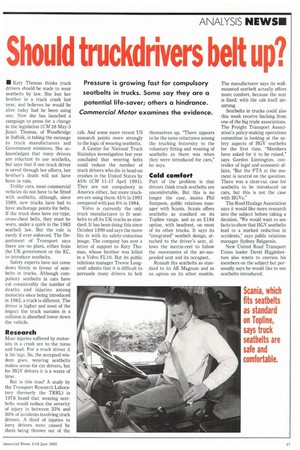Should truckdrivers belt up?
Page 19

If you've noticed an error in this article please click here to report it so we can fix it.
Pressure is growing fast for compulsory seatbelts in trucks. Some say they are a potential life-saver; others a hindrance. Commercial Motor examines the evidence.
• Katy Thomas thinks truck drivers should be made to wear seatbelts by law. She lost her brother in a truck crash last year, and believes he would be alive today had he been using one. Now she has launched a campaign to press for a change in the legislation (CM 28 May-3 June). Thomas, of Woodbridge in Suffolk, is taking the message to truck manufacturers and Government ministers. She acknowledges that many drivers are reluctant to use seatbelts, but says that if one truck driver is saved through her efforts, her brother's death will not have been in vain.
Unlike cars, most commercial vehicles do not have to be fitted with seatbelts, although, since 1989, new trucks have had to have anchorage points for belts. If the truck does have car-type, cross-chest belts, they must be worn, under a quirk in the 1983 seatbelt law. But the rule is rarely if ever enforced. The Department of Transport says there are no plans, either from the UK government or the EC, to introduce seatbelts.
Safety experts have not come down firmly in favour of seatbelts in trucks. Although compulsory seatbelts in cars have cut considerably the number of deaths and injuries among motorists since being introduced in 1983, a truck is different. The driver is higher and most of the impact the truck sustains in a collision is absorbed lower down the vehicle.
Research
Most injuries suffered by motorists in a crash are to the torso and head. For a truck driver it is his legs. So, the accepted wisdom goes, wearing seatbelts makes sense for car drivers, but for HGV drivers it is a waste of time.
But is this true? A study by the Transport Research Laboratory (formerly the TRRL) in 1978 found that wearing seatbelts would reduce the severity of injury in between 33% and 50% of accidents involving truck drivers. A third of injuries to lorry drivers were caused by them being thrown out of the cab. And some more recent US research points more strongly to the logic of wearing seatbelts.
A Center for National Truck Statistics investigation last year concluded that wearing belts could reduce the number of truck drivers who die in head-on crashes in the United States by 45% (CM 11-17 April 1991). They are not compulsory in America either, but more truckers are using them: 45% in 1991 compared with just 6% in 1984.
Volvo is currently the only truck manufacturer to fit seatbelts to all its UK trucks as standard. It has been doing this since October 1990 and says the move fits in with its safety-conscious image. The company has sent a letter of support to Katy Thomas, whose brother was killed in a Volvo FL 10. But its public relations manager Trevor Longcroft admits that it is difficult to persuade many drivers to belt themselves up. "There appears to be the same reluctance among the trucking fraternity to the voluntary fitting and wearing of seatbelts as there was when they were introduced for cars," he says.
Cold comfort
Part of the problem is that drivers think truck seatbelts are uncomfortable. But this is no longer the case, insists Phil Sampson, public relations manager with Scania. Scania offers seatbelts as standard on its Topline range, and as an £184 option, with headrest, on most of its other trucks. It says its Integrated" seatbelt design, attached to the driver's seat, allows the inertia-reel to follow the movements of the air-suspended seat and its occupant.
Renault fits seatbelts as standard to its AE Magnum and as an option on its other models. The manufacturer says its wallmounted seatbelt actually offers more comfort, because the seat is fixed; with the cab itself airsprung.
Seatbelts in trucks could also this week receive backing from one of the big trade associations. The Freight Transport Association's policy-making operations committee is looking at the safety aspects of HGV seatbelts for the first time. "Members have asked for it to be raised," says Gordon Linnington, controller of legal and economic affairs. "But the FTA at the moment is neutral on the question. There was a clear-cut case for seatbelts to be introduced on cars, but this is not the case with HGVs."
The Road Haulage Association says it would like more research into the subject before taking a decision. "We would want to see facts to show that HGV seatbelts lead to a marked reduction in accidents," says public relations manager Sydney Balgarnie.
New United Road Transport Union leader David Higginbottorn also wants to canvass his members on the subject but personally says he would like to see seatbelts introduced.














































































































